TYJW2-CMI Module Datasheet
Last Updated on : 2025-07-10 02:15:27download
Product overview
Developed by Tuya, TYJW2-CMI is a Wi-Fi module suitable for serial communication of the 5V TTL. It consists of a highly integrated wireless RF chip (ESP8266EX) and an external flash chip, with an embedded Wi-Fi network protocol stack and rich library functions. TYJW2-CMI includes a low-power 32-bit CPU, 2-MB flash memory, and 36-KB SRAM.
TYJW2-CMI is an RTOS platform that integrates all function libraries of the Wi-Fi MAC and TCP/IP. Based on the serial communication manner, you can develop the embedded Wi-Fi products as required.
Features
- Embedded with a low-power 32-bit CPU, which can also function as an application processor (The clock rate supports 80 MHz and 160 MHz)
- Operating voltage: 4.5 to 5.5V
- Peripheral: 1 UART (5V TTL)
- Wi-Fi connectivity
- 802.11 b/g/n
- Channels 1 to 14@2.4GHz
- Support WPA/WPA2 security mode
- Up to + 20dBm output power in 802.11b mode
- Support STA/AP/STA+AP working mode
- Support SmartConfig for Android and iOS devices
- PCB antenna
- Operating temperature: -20℃ to 85℃
Applications
- Intelligent building
- Smart household
- Medical health care
- Industrial wireless control
- Handheld devices
Module interfaces
Dimensions and footprint
The electrical interface of TYJW2-CMI is the PHS connector with a spacing of 2.0 mm.
The dimensions of TYJW2-CMI are 49.6±0.35 mm (W)×31±0.35 mm (L)× 9.1±0.15 mm (H):
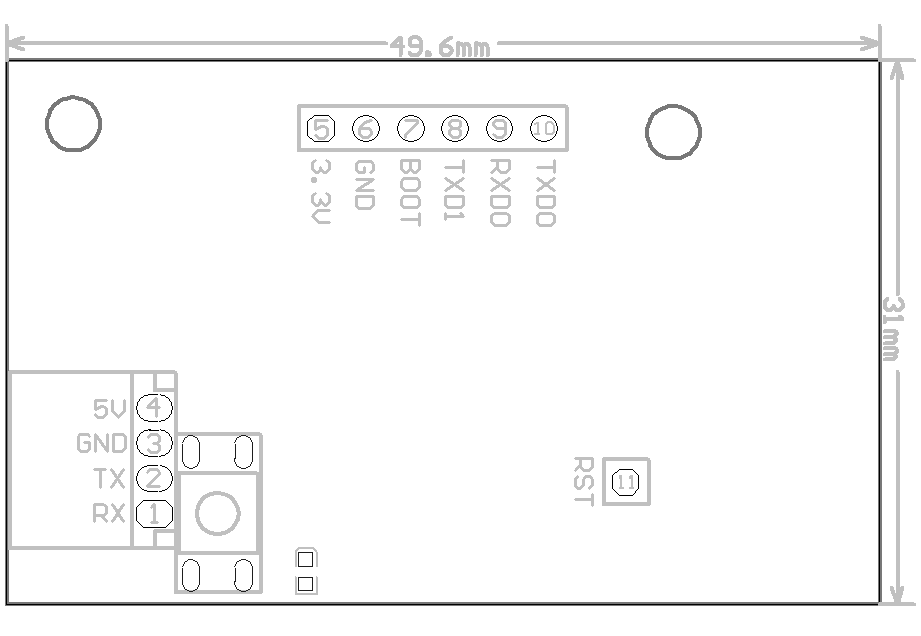
Pin definition
The definitions of pins of TYJW2-CMI are shown in the following table:
| Pin number | Symbol | Type | Function |
|---|---|---|---|
| 1 | RX | I/O | The receiving interface of the module, which inputs the TTL level signal in the voltage of 5V |
| 2 | TX | I/O | The transmitting interface of the module, which outputs the TTL level signal in the voltage of 5V |
| 3 | GND | P | Power supply reference ground |
| 4 | VCC | P | Power input pin, 5V |
Note: P indicates a power supply pin and I/O indicates an input/output pin
Definitions on test pins
The definitions of test pins of TYJW2-CMI are shown in the following table:
| Pin number | Symbol | Type | Function |
|---|---|---|---|
| 5 | 3.3V | P | Power supply pin inside the module (3.3V) |
| 6 | GND | P | Power supply reference ground |
| 7 | BOOT | I/O | Interface 0, it’s the pin for enabling/disabling the burning of the firmware of the module. |
| 8 | TXD1 | I/O | An interface for displaying information of the module |
| 9 | RXD0 | I/O | An interface for programming firmware of the module |
| 10 | TXD0 | I/O | An interface for programming firmware of the module |
| 11 | RST | I/O | Hardware reset pin |
Note:
- P indicates a power supply pin and I/O indicates an input/output pin.
- When the I/O 0 is pulled up, the module runs normally. When I/O 0 is at low level, the module is in the state of firmware programming.
- RST is only a hardware reset pin and cannot be used for clearing information about- network configuration.
- Test pins are not recommended for use.
Electrical parameters
Absolute electrical parameters
| Parameter | Description | Minimum value | Maximum value | Unit |
|---|---|---|---|---|
| Ts | Storage temperature | -20 | 85 | ℃ |
| VCC | Supply voltage | -0.3 | 5.5 | V |
| ESD voltage (human body model) | TAMB-25℃ | - | 2 | KV |
| ESD voltage (machine model) | TAMB-25℃ | - | 0.5 | KV |
Working conditions
| Parameter | Description | Minimum value | Typical value | Maximum value | Unit |
|---|---|---|---|---|---|
| Ta | Operating temperature | -20 | - | 85 | ℃ |
| VCC | Operating voltage | 4.5 | 5 | 5.5 | V |
| VIL | Voltage Input Low | -0.3 | - | VCC*0.25 | V |
| VIH | Voltage Input High | VCC*0.75 | - | VCC | V |
| VOL | Voltage Output Low | - | - | VDD*0.1 | V |
| VOH | Voltage Output High | VCC* 0.8 | - | VCC | V |
| Imax | I/O drive current | - | - | 5 | mA |
Wi-Fi transmission power consumption
TX power consumption:
| Symbol | Mode | Rate | Typical value | Unit |
|---|---|---|---|---|
| IRF | 11b | 11Mbps | 260 | mA |
| IRF | 11g | 54Mbps | 100 | mA |
| IRF | 11n | MCS7 | 100 | mA |
Wi-Fi receiving power consumption
RX power consumption:
| Symbol | Mode | Rate | Typical value | Unit |
|---|---|---|---|---|
| IRF | 11b | 11Mbps | 70 | mA |
| IRF | 11g | 54Mbps | 70 | mA |
| IRF | 11n | MCS7 | 70 | mA |
Power consumption in operating mode
The operating current of TYJW2-CMI is shown below:
| Operating mode | Operating status, Ta = 25°C | Average value | Maximum value | Unit |
|---|---|---|---|---|
| Quick pairing | The module is in fast pairing state and the Wi-Fi indicator always flashes | 90 | 462 | mA |
| Hotspot | The module is in pairing state through the hotspot and the Wi-Fi indicator always flashes slowly | 101 | 451 | mA |
| Connected | The module is connected to the network and the Wi-Fi indicator is always on | 82 | 435 | mA |
| Disconnected state | The module is disconnected and the Wi-Fi indicator is off | 156 | 430 | mA |
RF features
Basic RF features
| Parameter | Description |
|---|---|
| Operating frequency | 2.400 to 2.4835 GHz |
| Wi-Fi standard | IEEE 802.11 b/g/n (channels 1 to 14) |
| Data transmission rate | 11b: 1, 2, 5.5, 11 (Mbps) 11g: 6, 9, 12, 18, 24, 36, 48, and 54 (Mbps) 11n: HT20 MCS 0~7 |
| Antenna type | PCB antenna |
Wi-Fi output power
TX power consumption:
| Parameter | Rate | Minimum value | Typical value | Maximum value | Unit |
|---|---|---|---|---|---|
| Average output power, 802.11b CCK Mode | 1M | - | 17 | - | dBm |
| Average output power, 802.11g OFDM Mode | 54M | - | 15 | - | dBm |
| Average output power, 802.11n OFDM Mode | MCS7 | - | 13.5 | - | dBm |
| Frequency error | -10 | - | 10 | ppm |
Wi-Fi receiving sensitivity
RX sensitivity
| Parameter | Rate | Minimum value | Typical value | Maximum value | Unit |
|---|---|---|---|---|---|
| PER<8%, RX sensitivity, 802.11b CCK Mode | 1 M | - | -91 | - | dBm |
| PER<10%, RX sensitivity, 802.11g OFDM Mode | 54M | - | -75 | - | dBm |
| PER<10%, RX sensitivity, 802.11n OFDM Mode | MCS7 | - | -72 | - | dBm |
Antenna information
Antenna type
It adopts the PCB antenna with a gain of 2.5 dBi.
Antenna interference reduction
-
To ensure the optimal Wi-Fi performance when the Wi-Fi module uses a PCB antenna, it is recommended that the antenna be at least 15 mm away from other metal parts.
-
To prevent adverse impact on the antenna radiation performance, avoid copper or traces within the antenna area on the PCB.
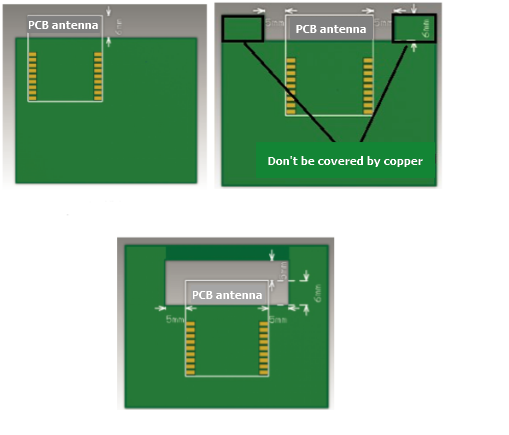
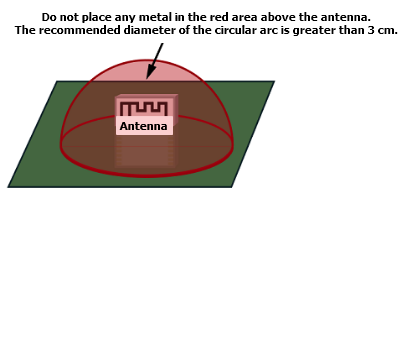
Packaging information and production instructions
Mechanical dimensions
The dimensions of the PCB: 49.6±0.35 mm (W)×31±0.35 mm (L) ×1.6±0.15 mm (H).
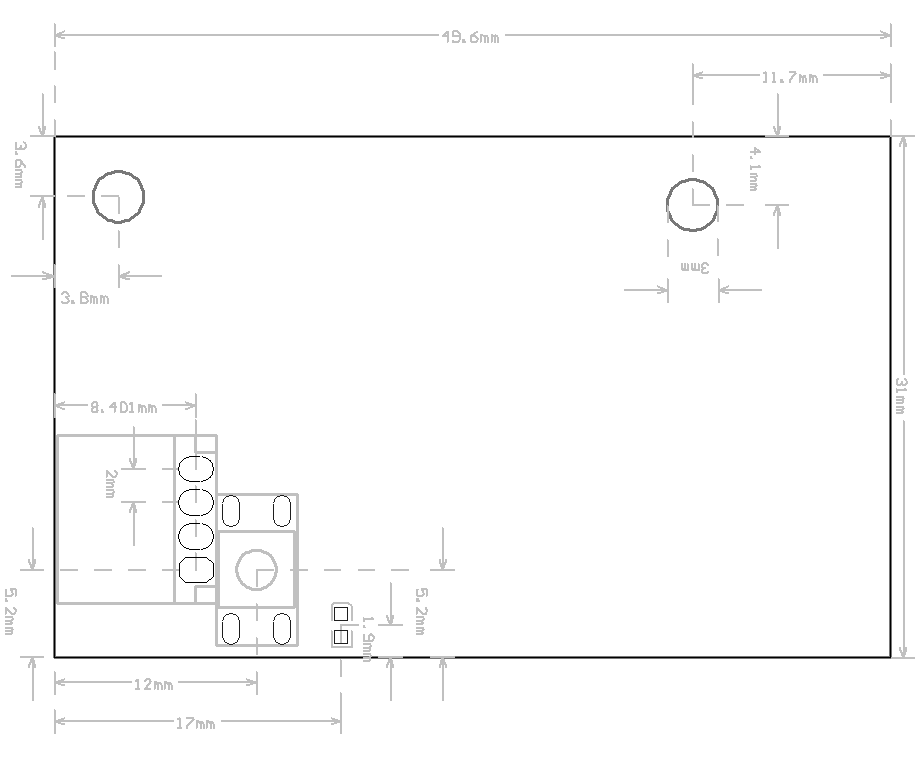
Specifications of connection wire
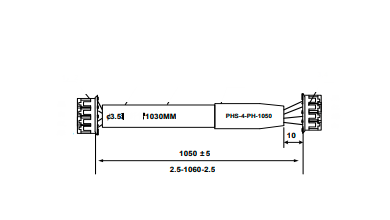
Production instructions
Storage conditions for a delivered module:
- The moisture-proof bag must be placed in an environment where the temperature is below 30°C and the relative humidity is lower than 85%.
- The shelf life of a dry-packaged product is 6 months from the date when the product is packaged and sealed.
Caution:
- In the production process, all operators must wear electrostatic rings.
- During operation, strictly prevent the module from getting wet or dirty.
Storage conditions
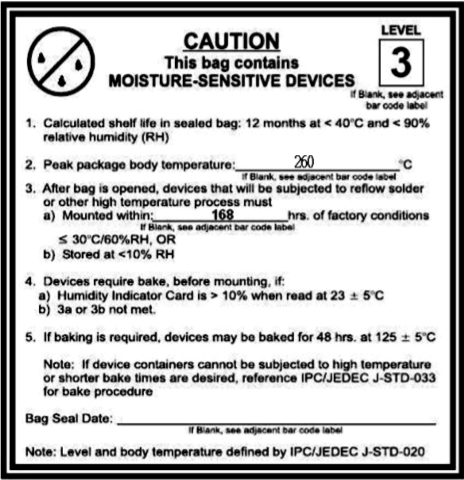
MOQ and packaging information
| Product model | MOQ (pcs) | Packaging method | Number of modules per carton | Number of reels per carton |
|---|---|---|---|---|
| TYJW2-CMI | 400 | Bubble bags | 200 | 2 |
Is this page helpful?
YesFeedbackIs this page helpful?
YesFeedback





